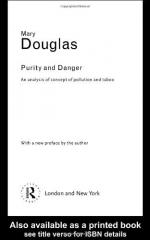
|
| Name: _________________________ | Period: ___________________ |
This test consists of 5 multiple choice questions, 5 short answer questions, and 10 short essay questions.
Multiple Choice Questions
1. What do the Bemba believe can transfer through fire?
(a) Murder.
(b) Premarital sex.
(c) Adultery.
(d) Incest.
2. Douglas states that pollution only involves situations that have which kind of structures?
(a) Clarified.
(b) Clearly defined.
(c) Clearly insulated.
(d) Clearly defiant.
3. What does Douglas claim is assured through collaboration?
(a) Internal lines.
(b) External boundaries.
(c) Pollution.
(d) Purity.
4. What type of consequences does Douglas state cannot be reversed?
(a) Social.
(b) Relationship.
(c) Economic.
(d) Religious.
5. What do boundaries represent to Douglas?
(a) Religion.
(b) Purity.
(c) Shape.
(d) Danger.
Short Answer Questions
1. The model of sexual energy that Douglas describes is a basis of what?
2. What pollution does the Bushong king practice as a part of sacrifice?
3. In the Hebrew religion, what could only be touched through sacrifice?
4. What do the Dinka people try to control more than other cultures, according to Douglas?
5. What can be changed through the margins Douglas describes?
Short Essay Questions
1. Why does Douglas say that social consequences cannot be reversed?
2. Why does Douglas state that pollutions are dangerous?
3. Are the arguments that Douglas poses in regards to primitive cultures being thought of as primitive and neurotic valid? Why or why not?
4. Why is dirt regarded as being a powerful part of a ritual, according to Douglas?
5. Describe the Coorgs' caste system.
6. Compare and contrast the Nuers and Bedouins on political structure.
7. How do internal and external boundaries, described by Douglas, relate to the human body?
8. How is infidelity handled in a Nuer society?
9. Describe the enforcements of harmony that Douglas introduces.
10. Describe the structure of the Lugbara.
|
This section contains 659 words (approx. 3 pages at 300 words per page) |

|




